In America, Independence Day is a really big deal. It's the titular anniversary of the day we tossed off the shackles of tyrannical monarchy and unfair taxation, shortly replacing it with ignorant misrepresentation and unfair taxation. Some people celebrate this holiday by tossing cash semi-legal fireworks vendors to procure a product that they will literally burn and explode in the street and leave the remains to float away in the evening wind. Or, you know, clog up the storm drain. America can be a confusing place, even for the natives.
I don't prescribe to the fireworks game plan much. Fireworks are most often used after dark, and I'm frequently far too intoxicated after dark to mix such things as fire and explosions. That kind of tom foolery is for the day time, and if you're going to do it, you should really do it right. So last weekend while my brother-in-law was in town, we went out to the desert for some good ol fashioned Independence Day Shooting At Things fun.
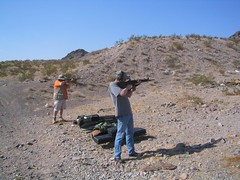
Peter had brought a number of firearms with him, and so had my good friend Jeff, so we had a grip of guns and between us we had far more ammunition than we could realistically shoot before the July sun tried to kill us and pick our bones for the pleasure of the desert. What we didn't have was much to shoot at. I had a few old hard drives, but nothing really heavy. Nothing worthy of science. "Don't worry" I admonished them as we bounced along the gas line road, "Arrakis provides." And so it did.
We stopped a few times and picked up things like a steel rack to use as a stand to dangle things from and an old saw horse, also to dangle things from so that we could shoot them. The real treasure though, was an old cast iron disk brake rotor. Now we were talking! Now we had some science to shoot at!
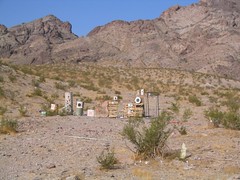
We set up our stands, attached the science target and set out to 'test' the ballistic performance of disk brakes. I'll tell you right away, disk brakes do an awesome job of stopping cars from doing silly things like ramming into other cars, but they're not really the kind of thing I'd want to hide behind in a fire fight, unless my opponent was armed solely with hand guns, and was a really good shot. Seriously, disk brakes aren't that big, and there's a big hole in the middle of them.
We started off at approximately 10 meters with the .40 Glock, which did nothing but splatter against the iron with a sharp ring and an impressive splatter. Peter, seeing the bullet splatter decided to move farther away behind me during the shooting section of Science. This is only important to note because Peter did not get shot that morning.
The .40 was followed by the .223 AR-15, the .303 Enfield, the .30-06 Springfield, and the .30-30 Marlin. That's really where we ran into a bit of a road block. The .223, .303, and .30-06 ammo was all FMJ while the .30-30 was a winchester XM2 soft nosed deer round. The FMJ ammo all cleanly and neatly penetrated the iron brake rotor and the thirty caliber rounds all popped out impressive chunks of metal on the back side. While the .30-30 round was more than powerful enough to bust through the iron, it was also real soft. At that range, and on that kind of target, it seems to have a tendency to fragment and ricochet rather unpredictably.
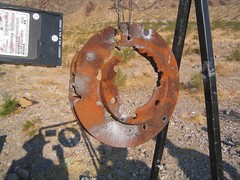
As soon as I took the shot with the Marlin, Jeff casually mentioned, "I'm hit" in a tone of voice that didn't really suggest panic or danger. "I took some shrapnel" he clarified and I jogged over to see what he was so politely not panicking about. Turns out a piece of the jacket had caught a ridge in the rotor and peeled off, shoot back at us and catching Jeff in the wrist. It was a good pea sized junk of the jacket a little bit of the slug and had dug firmly into the soft flesh surrounding Jeff's meaty wrist.
I had shot my best friend of twenty years.
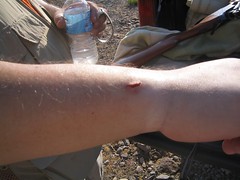
He casually picked out the fragment and walked towards the truck, discarding the piece of bullet without thinking about retaining the trophy. We gave the wound a little cleaning, examined it for damage, determined it was a minor flesh wound, and applied the real life equivalent of a video game health pack, the band-aid.
When we resumed shooting for science, Jeff stood farther back. I felt it was important to test the .30-30 again and took more careful aim this time. Predictably I took a piece of shrapnel in the forearm. I was a little disappointed when I discovered that the fragment was tiny. A part of me was hoping I would wound myself at least as badly as I did my good friend, who didn't want to get shot, so that I might gain some kind of karmic balance. I couldn't take back the chunk of bullet in Jeff's wrist, but maybe I could put a larger one in me somewhere fleshy. I would have been okay with that. I hurt myself all the time, some times on purpose. Of course, I wasn't willing to actually shoot myself directly, especially not after seeing what these bullets where doing to cast iron.
We finished off the science portion of the day with a 2 3/4 inch 12 gauge slug. This turned out to be the surprise ballistics performer of the day. The other rifled rounds all cut clean(ish) holes in the brittle iron. This wasn't surprising considering the velocity of some of the rounds. I didn't expect the 12 gauge slug to do much tough, and so I was surprised when both test rounds punched through, making impressive ragged exits. While the rifle rounds seemed to nearly machine cut their way through, the 12 gauge slug by comparison made a whole that could have just as easily been made by a hammer.
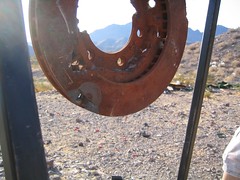
In all seriousness though, we got lucky, and I realize that. This is an excellent example of how unpredictable and dangerous fire arms can be if not treated with respect. We, and when I say "we" I really mean "Jeff," got very lucky. The bullet fragment hit him in a place not covered by clothing that could stick in the wound and become infected, and it didn't hit him in the face or some other delicate bit.
Respect the power of your firearm.





